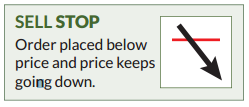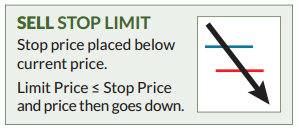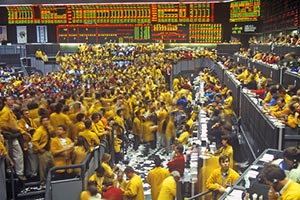Today I’m going to share a true work of fiction. Only the names have been changed to protect the not-so-innocent.
It’s based on life on the trading floor back in the day and how, if you tip your hand too much, the competition can make your life hell, and make out like a bandit, really fast.
This is what led me to create a really useful trading tool that we use in my Capital Wave Forecast and Zenith Trading Circle services when a little “secrecy” is called for.
Let me show you how it works…
How Stops Usually Work
First, we need to take a quick look at the two most basic types of stop orders.
 With a regular “stop-loss” order, an investor designates a stop-loss price. That price is a trigger price.
With a regular “stop-loss” order, an investor designates a stop-loss price. That price is a trigger price.
When the stock hits that price, a stop-loss order becomes a “market order.” The investor might get the exact price he designated as his stop-loss price, but, since the order turns into a “market order” when the designated price is triggered (meaning the stock trades at that price or through it), the investor, if he’s selling, will be filled at whatever the next bid price is, and he may have to sell at even lower prices if there aren’t enough shares at any close-by bid prices to fill his entire order.
 With a “stop-limit” order, the investor attaches a “limit price” to his stop order. The limit price is the trigger price, the same as it is with a plain stop-loss order.
With a “stop-limit” order, the investor attaches a “limit price” to his stop order. The limit price is the trigger price, the same as it is with a plain stop-loss order.
But with a stop-limit order, the investor is only willing to sell at the limit price he designates. He may or may not sell shares at his limit price when it is triggered.
[ad#Google Adsense 336×280-IA]A stock can trade right through an investor’s limit price and keep falling, and he won’t get filled.
A stop limit is used when you only want to sell at a specific price and won’t accept anything lower.
In my trading services, very often, if not most of the time, we use plain old stop-loss orders.
I don’t like stop-limit orders because you may not get filled at your limit price.
We use stop-loss orders because we want out of a position.
The trigger price is secondary, because we’re not hung up emotionally on the money.
We want out, and we want out quickly.
Now, here’s the cool part. There’s another kind of stop order we use – sometimes.
I call it a “mental stop.”
A “mental stop” is the exact same thing as a stop-loss order, with one very BIG difference. It’s a mental stop because I want us to keep it in our heads and not actually put down an order with a broker or on any exchange.
I’ll tell you why – there was a perfect example this week.
After we just booked a fat 100%-plus profit on half of this retailer put options position, I recommended we use a “mental stop” on the other half of our position and sell if the puts traded back down to $0.24, which if triggered would get us out with a 50% gain on the remainder of our position. Again, a mental stop would mean that if the puts trade down to $0.24, we immediately put down market orders to sell our remaining position.
Maybe some folks put down actual stop-loss orders at $0.24. It could have been us, it could have been someone else, but they traded down to $0.24, and we had to get out.
Now, here’s the inside scoop, the real story, on what can happen when actual stop orders get put down on an exchange or are given to “brokers.”
How It Really Works in the Trading Pits
In the old days (the early 1980s), when I was a market maker on the floor of the Chicago Board Options Exchange (CBOE), I’d go into a trading pit to trade. I’d trade the actual stock through my clerks, who I’d signal my orders to, and they’d execute them over the direct lines I had to the floor of the NYSE or to over-the-counter market makers I wanted to use, and I’d execute the options trades myself in the pit directly with other market makers or brokers.
I used to “trade size” (meaning big lots), which made me friendly with other big traders who also wanted to trade size. Some of those traders were market makers, and some of them were brokers, and because the CBOE allowed it, some of them were market makers who also had a “book” of customer orders. It looks like a deck of cards with orders written on them.
Here’s the not-quite-true story part… based on first-hand experience.
Suppose a big market maker, we’ll call him Axe, goes into a pit and wants to buy XYZ put options at $0.50, and they’re trading at $0.52.
 Now, Axe is known to trade size, so the other traders in the pit are going to keep an eye on Axe, to see what he’s doing, and how it might affect their positions or the direction of the stock.
Now, Axe is known to trade size, so the other traders in the pit are going to keep an eye on Axe, to see what he’s doing, and how it might affect their positions or the direction of the stock.
Let’s further suppose a friendly market maker or broker, one who also usually trades size, quietly asks Axe what he wants to do, or, if he’s got a book, he might “accidentally” show Axe his book, revealing a large stop-loss order to sell those very same put options Axe’s interested in at $0.49.
That is valuable information, especially if Axe wants to buy those puts for less than the $0.52 they’re currently trading at, and better yet, lower than the $0.50 he was willing to pay for them.
Let’s say the market for the options was “50-52,” meaning there was a $0.50 bid to buy and a $0.52 offer to sell, and they were trading at $0.52.
Usually, a market quote, like 50-52, is accompanied by the size on both the bid and offer. So, the full market quote might be “50-52, 20×50.” That means somebody, or a broker combining some orders, is bidding (wants to buy) $0.50 for 20 lots. The offer side is $0.52, and there are currently 50 lots being offered for sale there.
So, Axe knows there are only 20 lots being bid for at $0.50. There may be more buyers out there at $0.50 that aren’t being shown in the crowd, but 20 lots is all that’s being shown right now.
Axe, if he’s smart, and he is, could immediately “hit the bid,” which means sell the buyer the 20 lots at $0.50 he wants. Since he’s Axe, and the crowd thinks Axe trades size (is a big seller), there may be no more $0.50 bids, because no one wants to get in front of Axe selling.
Here’s where psychology comes in the pit. If the other market makers think Axe is a big seller, they may want to get out of the way and sell their positions before he crushes them. So, a market maker might immediately change the market to 49-50, meaning he’ll pay $0.49 and sell at $0.50 like Axe seems to want to do.
Axe, being the player he is, can hit that $0.49 bid (sell at $0.49) for the small amount the market maker wants to buy there. Since the market maker doesn’t really want to buy, his $0.49 bid might be for just 10 lots, which Axe sells to him.
Now, guess what? The option just traded for $0.49!
And the broker with the big stop-loss order to “sell size” if the option trades $0.49 has to sell.
He’ll yell out “At 49,” meaning he’s just changed the market and he wants to sell at $0.49.
And guess who’s standing right next to him and yells, “Buy ’em!”
That would be Axe.
How Our “Axe” Makes Out Like a Bandit
What a coincidence! Lo and behold, the stop-loss order that was “away from the market” magically gets “hit,” and all those options get sold cheaply to Axe, our antihero… unless of course you’re a limited partner in Axe’s hedge fund.
Now, if there aren’t any other sellers in the pit at $0.49 or lower, Axe will change the market himself and make it 50-52 if he can. That means Axe, as a market maker, is now willing to buy those same options, the ones he just bought at $0.49, at the new bid price of $0.50, and he’s willing to sell them at $0.52.
If anybody else wants to buy, they might also join the bid at $0.50.
If Axe is lucky, a lot of orders stack up to buy at $0.50. Or maybe, because everyone in the crowd now knows Axe is a big buyer, they’ll bid the options right back up to $0.52, where they were before any of this happened and before that big stop-loss order at $0.49 got “hit”… like an armadillo by an 18-wheeler.
“Lucky” Axe is now holding a big bunch of options he bought at $0.49 and can sell at $0.50, $0.52, or maybe even higher for a quick, no-risk profit.
Of course, this is just a story, for illustrative purposes.
But I think you get it: Stuff happens to stop-loss orders.
A “mental stop” is the exact same thing as a stop-loss order, with one very BIG difference.
And that was back then.
It’s even worse today.
That’s because high-frequency trading (HFT) shops, with their crazy-fast computers, capable of seeing orders even before they reach the exchanges they’re directed to, can play the exact same games – at the speed of light.
And they do.
And so do the market makers who sit on the brokerage desks that some orders are sent to.
That’s why I recommend “mental stops.”
If you don’t put an order down, it can’t be picked off.
That’s why I love using them. Go get ’em.
— Shah Gilani
[ad#mmpress]
Source: Money Morning
